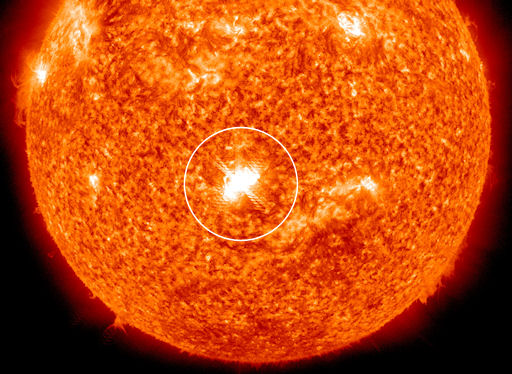EARTH-DIRECTED SOLAR FLARE: On Feb. 13th at 1738 UT, sunspot 1158 unleashed the strongest solar flare of the year so far, an M6.6-category blast. NASA's Solar Dynamics Observatory recorded an intense flash of extreme ultraviolet radiation, circled below:
The eruption produced a loud blast of radio waves heard in shortwave receivers around the dayside of our planet. In New Mexico, amateur radio astronomer Thomas Ashcraft recorded these sounds at 19 to 21 MHz. "This was some of the strongest radio bursting of the new solar cycle," he says. "What a great solar day."
Preliminary coronagraph data from STEREO-A and SOHO agree that the explosion produced a fast but not particularly bright coronal mass ejection (CME). The cloud will likely hit Earth's magnetic field on or about Feb. 15th. High-latitude sky watchers should be alert for auroras.
The source of this activity, sunspot 1158 is growing rapidly (48 hour movie). The active region is now more than 100,000 km wide with at least a dozen Earth-sized dark cores scattered beneath its unstable magnetic canopy. More Earth-directed eruptions are likely in the hours ahead.


Comments
There have also been multiple Gamma ray burst over the pass 7 days which show up as the red dots.
It did go into the "X"...."Y's" are next...
Earth Changes Media is reporting a second M-class earth-directed flare has occurred from region 1158.
got this from space weather, i have not found any other info on this comet, so that would tell me that there are still items out there that NASA are not telling the public about, and if that is the case then this CME could push items towards the earth.
COMET ENCOUNTER-TONIGHT! NASA's Stardust-NExT probe is plunging toward Comet Tempel 1 for a Valentine's Day encounter designed to reveal how solar heat devours the icy cores of comets. Closest approach happens at 8:37 p.m. PST (11:37 p.m. EST) on Feb. 14th. Stay tuned for fantastic images.
I came across this and the area of concentration of quakes in Chile over the past 7 days, seems to correspond with the same area of unusally rainfall in the southern coast of Chile.
-
1
-
2
of 2 Next